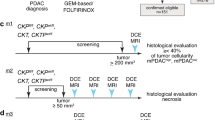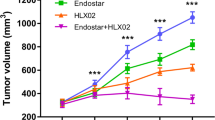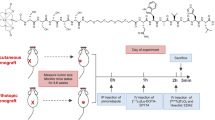Abstract
Purpose
To analyse the influence of cancer-associated stroma on FDG-uptake in two carcinoma models characterized by different stromal degrees.
Methods
Eight nude mice were subcutaneously injected with DU-145 prostate cancer cells or BXPC-3 pancreatic cancer cells, and underwent FDG-PET imaging about 2 weeks after implantation. After the mice were killed, histology, and CD31 and GLUT1 immunohistochemistry were performed. To further evaluate the highly stromalized carcinoma using perfusion-sensitive imaging, four BXPC-3 tumours underwent two successive albumin-binding (MS-325) MRI scans during tumour growth.
Results
FDG uptake was significantly higher in the DU-145 than in the BXPC-3 tumours, which were hardly distinguishable from adjacent normal tissue. In the BXPC-3 tumours, histology confirmed the widespread presence of aberrant infiltrated stroma, embedded with numerous vessels marked by CD31. In both tumour types, the stromal matrix was negative for GLUT1. In DU-145 tumour cells, GLUT1 immunostaining was greater than in BXPC-3 tumour cells, but not homogeneously, since it was less evident in the tumour cells which were nearer to vessels and stroma. Finally, MS-325 MRI always clearly showed areas of enhancement in the BXPC-3 tumours.
Conclusion
Cancer-associated stroma has been reported to be capable of aerobic metabolism with low glucose consumption. Furthermore, it has been proposed that regions with high vascular perfusion exhibit a significantly lower FDG uptake, suggesting some vascular/metabolic reciprocity. Since our results are consistent with these recent findings, they signal a risk of tumour volume underestimation in radiotherapy if FDG uptake alone is used for target delineation of carcinomas, which suggests that additional evaluation should be performed using vasculature/perfusion-sensitive imaging.




Similar content being viewed by others
References
Lardinois D, Weder W, Hany TF, Kamel EM, Korom S, Seifert B, et al. Staging of non-small-cell lung cancer with integrated positron-emission tomography and computed tomography. N Engl J Med 2003;348:2500–7.
Gregoire V, Haustermans K, Geets X, Roels S, Lonneux M. PET-based treatment planning in radiotherapy: a new standard. J Nucl Med 2007;48 (Suppl):68S–77S.
Lardinois D. New horizons in staging for non-small-cell lung cancer. J Clin Oncol 2006;24:1785–7.
Wang D, Schultz CJ, Jursinic PA, Bialkowski M, Zhu XR, Brown WD, et al. Initial experience of FDG-PET/CT guided IMRT of head-and-neck carcinoma. Int J Radiat Oncol Biol Phys 2006;65:143–51.
Schwartz DL, Ford EC, Rajendran J, Yueh B, Coltrera MD, Virgin J, et al. FDG-PET/CT-guided intensity modulated head and neck radiotherapy: a pilot investigation. Head Neck 2005;27:478–87.
Geets X, Daisne JF, Tomsej M, Duprez T, Lonneux M, Gregoire V. Impact of the type of imaging modality on target volume delineation and dose distribution in pharyngo-laryngeal squamous cell carcinoma: comparison between pre- and per-treatment studies. Radiother Oncol 2006;78:291–7.
Nestle U, Kremp S, Schaefer-Schuler A, Sebastian-Welsch C, Hellwig D, Rube C, et al. Comparison of different methods for delineation of 18F-FDG PET-positive tissue for target volume definition in radiotherapy of patients with non-small cell lung cancer. J Nucl Med 2005;46:1342–8.
Biehl KJ, Kong FM, Dehdashti F, Jin JY, Mutic S, El Naga I, et al. 18F-FDG PET definition of gross tumor volume for radiotherapy of non-small cell lung cancer: is a single standardized uptake value threshold approach appropriate. J Nucl Med 2006;47:1808–12.
Hong R, Halama J, Bova D, Sethi A, Emami B. Correlation of PET standard uptake value and CT window-level thresholds for target delineation in CT-based radiation treatment planning. Int J Radiat Oncol Biol Phys 2007;67:720–6.
Macmanus MP, Hicks RJ. Where do we draw the line? Contouring tumors on positron emission tomography/computed tomography. Int J Radiat Oncol Biol Phys 2008;71:2–4.
Gregoire V, Bol A, Geets X, Lee J. Is PET-based treatment planning the new standard in modern radiotherapy? The head and neck paradigm. Semin Radiat Oncol 2006;16:232–8.
van Baardwijk A, Baumert BG, Bosmans G, van Kroonenburgh M, Stroobants S, Gregorie V, et al. The current status of FDG-PET in tumour volume definition in radiotherapy treatment planning. Cancer Treat Rev 2006;32:245–60.
Daisne JF, Duprez T, Weynand B, Lonneux M, Hamoir M, Reychler H, et al. Tumor volume in pharyngolaryngeal squamous cell carcinoma: comparison at CT, MR imaging, and FDG PET and validation with surgical specimen. Radiology 2004;233:93–100.
van Baardwijk A, Bosmans G, Boersma L, Buijsen J, Wanders S, Hochstenbag M, et al. PET-CT-based auto-contouring in non-small-cell lung cancer correlates with pathology and reduces interobserver variability in the delineation of the primary tumor and involved nodal volumes. Int J Radiat Oncol Biol Phys 2007;68:771–8.
Stroom J, Blaauwgeers H, van Baardwijk A, Boersma L, Lebesque J, Theuws J, et al. Feasibility of pathology-correlated lung imaging for accurate target definition of lung tumors. Int J Radiat Oncol Biol Phys 2007;69:267–75.
van Baardwijk A, Bosmans G, van Suylen RJ, van Kroonenburgh M, Hochstenbag M, Geskes G, et al. Correlation of intra-tumour heterogeneity on (18)F-FDG PET with pathologic features in non-small cell lung cancer: a feasibility study. Radiother Oncol 2008;87:55–8.
Koukourakis MI, Giatromanolaki A, Harris AL, Sivridis E. Comparison of metabolic pathways between cancer cells and stromal cells in colorectal carcinomas: a metabolic survival role for tumor-associated stroma. Cancer Res 2006;66:632–7.
Galiè M, Farace P, Nanni C, Spinelli A, Nicolato E, Boschi F, et al. Epithelial and mesenchymal tumor compartments exhibit in vivo complementary patterns of vascular perfusion and glucose metabolism. Neoplasia 2007;9:900–8.
Henriksson E, Kjellen E, Wahlberg P, Ohlsson T, Wennerberg J, Brun E. 2-Deoxy-2-[18F] fluoro-D-glucose uptake and correlation to intratumoral heterogeneity. Anticancer Res 2007;27:2155–9.
Farace P, Galiè M, Nanni C, Spinelli A, Fanti S. Contouring carcinomas by FDG-PET: is the role of tumor-biology underestimated?: in regard to MacManus and Hicks (Int J Radiat Oncol Biol Phys 2008;71:2–4). Int J Radiat Oncol Biol Phys 2008;72:303–4.
Spinelli AE, D’Ambrosio D, Pettinato C. Performance evaluation of a small animal PET scanner. Spatial resolution characterization using 18-FDG-PET and 11-C. Nucl Instrum Methods 2006;571:215–8.
Bos R, Der Hoeven JJ, van Der WE. Biologic correlates of (18)fluorodeoxyglucose uptake in human breast cancer measured by positron emission tomography. J Clin Oncol 2002;20:379–87.
Hunter GJ, Hamberg LM, Choi N, Jain RK, McCloud T, Fischman AJ. Dynamic T1-weighted magnetic resonance imaging and positron emission tomography in patients with lung cancer: correlating vascular physiology with glucose metabolism. Clin Cancer Res 1998;4:949–55.
van Laarhoven HW, Geus-Oei LF, Wiering B, Lok J, Rijpkema M, Kaanders JH, et al. Gadopentetate dimeglumine and FDG uptake in liver metastases of colorectal carcinoma as determined with MR imaging and PET. Radiology 2005;237:181–8.
Tateishi U, Nishihara H, Tsukamoto E, Morikawa T, Tamaki N, Miyasaka K. Lung tumors evaluated with FDG-PET and dynamic CT: the relationship between vascular density and glucose metabolism. J Comput Assist Tomogr 2002;26:185–90.
Miles KA, Griffiths MR, Keith CJ. Blood flow-metabolic relationships are dependent on tumour size in non-small cell lung cancer: a study using quantitative contrast-enhanced computer tomography and positron emission tomography. Eur J Nucl Med Mol Imaging 2006;33:22–8.
Miles KA, Griffiths MR, Fuentes MA. Standardized perfusion value: universal CT contrast enhancement scale that correlates with FDG PET in lung nodules. Radiology 2001;220:548–53.
Stewart EE, Chen X, Hadway J, Lee TY. Correlation between hepatic tumor blood flow and glucose utilization in a rabbit liver tumor model. Radiology 2006;239:740–50.
Hirasawa S, Tsushima Y, Takei H, Hirasawa H, Taketomi-Takahashi A, Takano A, et al. Inverse correlation between tumor perfusion and glucose uptake in human head and neck tumors. Acad Radiol 2007;14:312–8.
Bisdas S, Spicer K, Rumboldt Z. Whole-tumor perfusion CT parameters and glucose metabolism measurements in head and neck squamous cell carcinomas: a pilot study using combined positron-emission tomography/CT imaging. AJNR Am J Neuroradiol 2008;29:1376–81.
Farace P, Nicolato E, Fiorini S, Merigo A, Sbarbati A, Marzola P. DCE-MRI with Magnevist® and Vasovist® in experimental tumor models characterized by different extent of cancer-associated stroma (abstract). 25th Annual Meeting of the European Society for Magnetic Resonance in Medicine and Biology (ESMRMB), October 2008.
Antoch G, Freudenberg LS, Beyer T, Bockisch A, Debatin JF. To enhance or not to enhance? 18F-FDG and CT contrast agents in dual-modality 18F-FDG PET/CT. J Nucl Med 2004;45(Suppl):56S–65S.
Pfannenberg AC, Aschoff P, Brechtel K, Muller M, Bares R, Paulsen F, et al. Low dose non-enhanced CT versus standard dose contrast-enhanced CT in combined PET/CT protocols for staging and therapy planning in non-small cell lung cancer. Eur J Nucl Med Mol Imaging 2007;34:36–44.
Sorensen M, Horsman MR, Cumming P, Munk OL, Keiding S. Effect of intratumoral heterogeneity in oxygenation status on FMISO PET, autoradiography, and electrode Po2 measurements in murine tumors. Int J Radiat Oncol Biol Phys 2005;62:854–61.
Dearling JL, Flynn AA, Sutcliffe-Goulden J, Petrie IA, Boden R, Green AJ, et al. Analysis of the regional uptake of radiolabeled deoxyglucose analogs in human tumor xenografts. J Nucl Med 2004;45:101–7.
Zhao S, Kuge Y, Mochizuki T, Takahashi T, Nakada K, Sato M, et al. Biologic correlates of intratumoral heterogeneity in 18F-FDG distribution with regional expression of glucose transporters and hexokinase-II in experimental tumor. J Nucl Med 2005;46:675–82.
Bhowmick NA, Neilson EG, Moses HL. Stromal fibroblasts in cancer initiation and progression. Nature 2004;432:332–7.
Hwang RF, Moore T, Arumugam T, Ramachandran V, Amos KD, Rivera A, et al. Cancer-associated stromal fibroblasts promote pancreatic tumor progression. Cancer Res 2008;68:918–26.
Korc M. Pancreatic cancer-associated stroma production. Am J Surg 2007;194(Suppl):S84–6.
Hofmeister V, Schrama D, Becker JC. Anti-cancer therapies targeting the tumor stroma. Cancer Immunol Immunother 2008;57:1–17.
Author information
Authors and Affiliations
Corresponding author
Rights and permissions
About this article
Cite this article
Farace, P., D’Ambrosio, D., Merigo, F. et al. Cancer-associated stroma affects FDG uptake in experimental carcinomas. Implications for FDG-PET delineation of radiotherapy target. Eur J Nucl Med Mol Imaging 36, 616–623 (2009). https://doi.org/10.1007/s00259-008-1012-x
Received:
Accepted:
Published:
Issue Date:
DOI: https://doi.org/10.1007/s00259-008-1012-x




